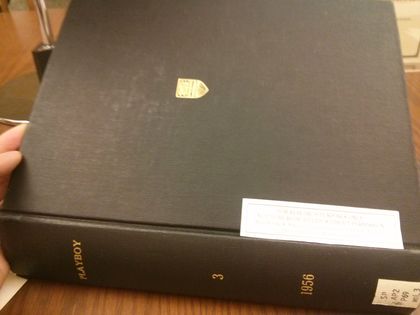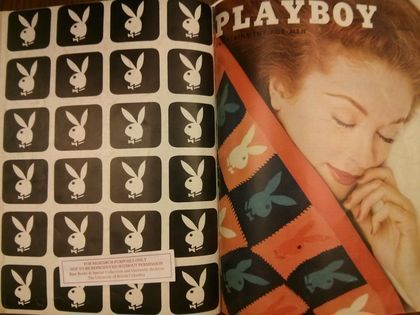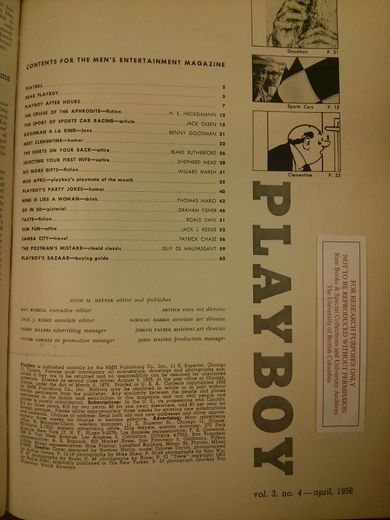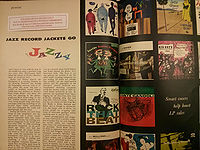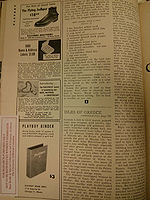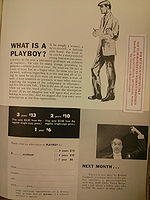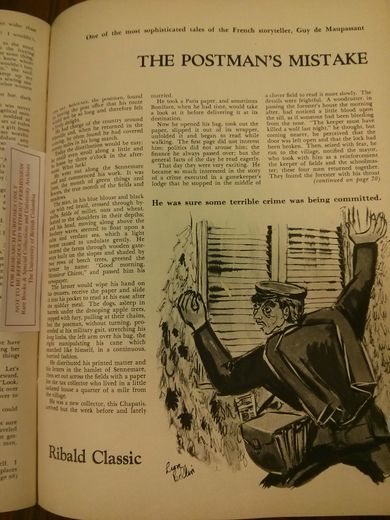Course:ENGL419/Books/Playboy Vol 3
| Playboy Vol.3 Catalogue | |
|---|---|
| January - December 1956 | |
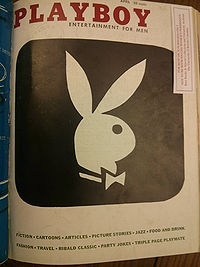 April 1956 Cover | |
| AP2.P69 | |
| ISSN: 0032-1478 | |
| Year of Publication | 1956 |
| Publisher | HMH Publishing Co. |
| Editors | Hugh Hefner, Ray Russell, Jack Kessie |
| Periodical | Volume 3, Issues 1-12 |
| UBC Library Link | |
Playboy magazine is a popular men's lifestyle magazine infamous for its centerfolds, nudes and explicit content, whilst publishing journalism on fine living as well as short fiction. UBC's Rare Books and Special Collections owns a collection of Playboy magazines, mainly as whole volumes consisting of a issues from one selective year. The oldest such catalogue owned by the RBSC is the 1956 copy, which contains all of volume 3, issues 1 to 12.
Physical Components
Binding, Procurement and Condition
Binding
This volume, containing every monthly edition of Playboy published in 1956, is presented in a generic black binding with the University's logo etched in Gold on the front. On the spine, the title reads Playboy with 1956 as well as a numerical 3 to mark the volume number. Could it be possible that the volume has intentionally minimal designs which would not hint at the explicit nature of its content? Unlikely, given the material it uses. Library binders tend to use generic acrylic-coated buckram covers The binding style used in this volume is twofold. Firstly, each individual magazine used a saddle stitching method with staples. This is the typical binding method for magazines, even today. Staple markings are evident in the July, issue 7 edition within the volume. However, to assemble the volume as a whole, it appears to use an oversewing binding method to secure each individual magazine. On some covers the cutting of the spine in the oversewing process was not completely straight, leading to a slightly rugged edge. This is compliant with the oversewing method of serials, where the existing spine is cut, freeing the pages into loose pages which affirms that each individual page would be affixed to the glue on the new binding.
Procurement
The University acquired this volume on August 26, 1969. Every monthly cover within this volume has been stamped, very faintly, with a University-branded logo with this date. No other markings exist - several blank pages precede the January cover which starts the volume. A full 1956 volume of Playboy magazines in today's collector market would fetch approximately $200 to $600 depending on condition. This cost is extremely low, especially compared to the single copy of the 1953 first issue, which can sell at over $3000.
Condition
All the pages are thoroughly used, with noticeable creases on many pages. Tears are very common, especially on the lower edge of the pages. The flimsy gloss paper material used in the magazines barely help in maintaining the condition of the book. The centerfold pages, full-page foldout spreads of nude models, are loose from having been repeatedly opened and closed. Also, the oversewing binding process does not seem to have done much good with the centerfold pages when they have been reassembled, since the pages, when folded, do not align with the side edge of the magazine.
Style
Most of the pages are black and white; pages with larger images or colored illustrations are in full color. The maximum number of columns on a page is three; however use of three columns is mainly limited to longer pieces, particularly the fiction segments. Typically two columns are used and the remaining space is used for advertising or images.
The articles written for Playboy are presented in many bits and pieces; most works which require more than one or two pages are require the reader to flip many pages to reach the next section, usually some ten to thirty pages later. This kind of layout makes reading very inconvenient but also promotes flipping back and forth - towards the end of the magazine all the final sections of each article make an appearance. The articles are all printed with a serif font most resembling Palatino, while headers and titles were printed with various sans-serif fonts. All the fonts, as well as the font of the PLAYBOY lettering on the covers, were designed in-house by Hefner's HMH Publishing Company. In the 1970s, font design would be outsourced to the International Typeface Corporation and designed by legendary typographer Ed Benguiat [1] until the digital era.
Context
Historical Context
Playboy was established in 1953 by Hugh Hefner with the help of a group of investors and his friend Eldon Sellers. Hefner had previously gained experience in the publishing industry by working as a copy writer, sales manager, and circulation promotion manager at a number of publishing companies[2]. Selling at 50 cents, the first issue featured American sex symbol Marilyn Monroe as the centerfold, which Hefner had secured from unused photos from a nude calendar shoot four years prior. Riding on Monroe's legendary status as well as Hefner's crafty marketing, Playboy became an instant hit, becoming one of the most read gentleman's magazines in America and having a readership in foreign countries.
Hefner relied on a large team of Jewish editors, whom did not flaunt their ethnic roots publicly. A number of the editors used both their real names as well as a pseudonym when publishing for Playboy; this is the case for associate editor Jack Kessie, whom used both his real name as well as the pen name "Blake Rutherford"[3]. The table of contents from the April edition demonstrates this perfectly. Kessie wrote both articles on fashion (under "attire"), but used two names in authorship. By doing this, Playboy would appear to have a large variety of skilled editors, while masking some of the Jewish influence which editors such as Kessie and Auguste Spectorsky had upon the magazine.
If girls were the only motivation for buying our magazines, they wouldn't sell. People would buy sheer smut. We, on the other hand, are Taste City.
- Hugh Hefner, interview with The Realist, 1961
Critics have conflicting attitudes about Playboy. On the one hand, there is the one viewpoint of Playboy as a patriarchal force bent on the objectification of women. Hefner designed the magazine not just to display nudes (and there were few of them in early editions such as in 1956), but also as part of "a bachelor lifestyle built on fine living and luxurious consumption ... a suave, sophisticated man-about-town, sexually liberated, irresistible to women"[4]. However, the alternative viewpoint takes note of Hefner's glorification of the "girl-next-door" theme: by sexualizing the girl-next-door, Playboy grants a degree of sexual desire and autonomy to women, aiming to "break down outmoded laws and attitudes regarding sex"[5].
The Logo
The April 1956 edition of Playboy, seen at the top of the page, was the first issue which incorporated the now famous Bunny logo into the cover. Note how the rabbit head faces right while the now-famous logo is left-facing. In the early years of Playboy, Hefner and his colleagues were undecided on the directionality of the rabbit logo. Most covers used a fluffy drawing of a rabbit head in a man's body depicting the Mr.Playboy figure. The April 1956 edition would go on to lay the foundations for the logo, albeit left facing, to appear, even if hidden, in the covers of every Playboy magazine a few years later.
Subject Matter
Lifestyle & Advertising
While mostly known as a more explicit magazine nowadays, the roots of Playboy are embedded in the culture of the suave, sophisticated gentleman. The Playboy reader was meant to be a "glorious consumer, a man on the rise in his chosen profession, whose efforts to earn and spend helped drive the economy and keep the nation strong"[6]. In the Cold War era, where the U.S. economy was seen as a group effort by all civilians, magazines such as Playboy were crucial to American stimulation of consumerism. The true playboy lived a lifestyle far beyond just the singular facets of partying and womanly affections. In fact, the magazine devoted itself into the education and refinement of men, by publishing a wide variety of different lifestyle pursuits. Reviews of theatre, music, and cinema graced the pages of Playboy in a likeness almost rivalling The New Yorker. For many in foreign countries who subscribed to Playboy, the magazine represented the "good life", even if they knew the young men of America didn't live like true Playboy heroes. Young men who lived by the principles of the magazine would ultimately lead more rewarding lives, given they followed advice on sophisticated dress, gentlemanly mannerisms, and knowledgeable pursuits.
As such, Playboy published a wide array of subject matter, mainly promoting lavish American consumerism. Some of these are:
- Travel Monologues, to exotic destinations
- Vehicles, particularly sports cars.
- Gadgets and Appliances: From hand mixers, cigar boxes to mini-fridges.
- Fashion and Attire: How to dress in different settings, picking the perfect umbrella, etc.
- Recipes: The bachelor must know how to cook, and mix drinks.
- Fine dining: Learning to appreciate different cuisines, holding a wine glass correctly, etc.
- Performing arts: Appreciation and listings for theatre, music, and cinema.
- Home decor: Interior design, to make a fine impression on visitors.
Scattered throughout and at the end of magazine, a number of ads are presented which detail clothing retailers, and other sellers of fine living items which a reader can buy by making a telephone purchase or by mail. Prices are listed for many of the items directly in the advertisement - for example, one could buy a pair of fine cufflinks for a bit over a dollar, by mail.
Fiction
The truly sophisticated playboy must be a literate, well-read man. Playboy is known for publishing short fiction and short stories by renowned authors such as Ray Bradbury, Vladimir Nabokov, and John Cheever. In the April 1956 issue, Playboy has included a story by Guy de Maupassant, The Postman's Mistake, which is more commonly known as Le crime au père Boniface, or Old Boniface's Crime. Playboy paid well for use of an author's fiction, and being published as a fiction writer in the magazine would provide the dividends of both generous pay as well as widespread recognition[7]. The magazine generally liked to publish short fiction which were either classics, science fiction, or stories which were veiled social or cultural commentaries. Stories tended to be approximately three to four pages long, usually with an illustration or brief comic. A recurring set of satirical articles produced by American writer Shepherd Mead graced every single issue in 1956, as a satirical men's help guide to dealing with women. Among these are gems such as "Selecting Your Second Wife" and "How to save money on your wife's clothing" which are written in a light, fun-loving tone, where Mead promotes activities such as women's field hockey as a wonderful priming mechanism towards the rigors of daily sweeping and mopping. Mead would eventually compile all of his satirical articles into the widely-read book How to Succeed with Women without Really Trying.
Nudity
It is to the credit of Hefner and his colleagues that the early Playboy issues relied less on its graphic content than its lifestyle advertising for sales. In fact, in a typical issue in 1956, nudity is kept at a very low minimum. While themes of promiscuity, casual dating and womanizing is a popular feature, especially in the Satire sections of the magazine, nude photographs only consistently appear on the fold-out centerfold which is the highlight of any Playboy magazine. In a magazine which averages between 80 to 100 pages, nudity is present in only 3-4 of them. Instead of using famous models and actresses, Hefner decided to use the girl-next-door type; ranging anywhere from students, secretaries, writers and other career women. This departure away from the femme-fatale type towards a cleaner image is reflected in the settings of the centerfolds, which are not overly extravagant and feature women in very conventional settings. (Pictures are not provided on this page as a result of graphic NSFW content.)
Notes
Works Cited
- Ambrose, Gavin & Harris, Paul. The Fundamentals of Typography. Lausanne: AVA Publishing SA, 2006. Print.
- Fraterrigo, Elizabeth. Playboy and the Making of the Good Life in Modern America. New York: Oxford University Press, 2009. Print.
- Lambert, Josh. "My Son, the Pornographer." TabletMag. Tablet Magazine, 24 Feb. 2009. Web. 18 Apr 2014.
- Miller, Russell. Bunny: The Real Story of Playboy. London: Corgi, 1985. Print.
- Pitzulo, Carrie. Bachelors and Bunnies: The Secret Politics of Playboy. Chicago: University of Chicago Press, 2011. Print.
- Watts, Stephen. Mr.Playboy:Hugh Hefner and the American Dream. Nashville: Turner, 2009. Print.
